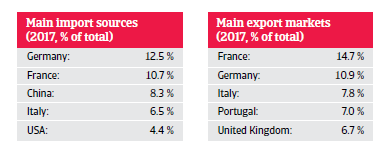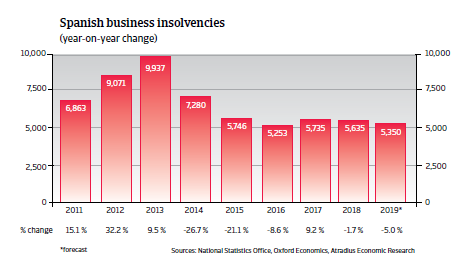Household consumption is sustained by rising employment, higher wages and low interest rates, while lower financing costs support business investments.


More improvement in insolvencies expected in 2019, but numbers remain high
Corporate defaults have closely mirrored economic conditions, with high year-on-year increases seen from 2011 to 2013. With the economic rebound, insolvencies have been declining almost every year since 2014, and this positive trend is expected to continue, with business failures forecast to decrease 5% in 2019.
However, this would still leave business insolvencies at a high level of about 5,350 cases. This is still much higher than in 2008, when about 3,300 cases were recorded.

Lower, but still robust growth rates expected in 2019 and 2020
Spain’s economic performance remained solid in 2018, with GDP increasing 2.5%. In 2019 and 2020 economic growth is expected to moderate somewhat, but to remain robust. Domestic demand remains the key driver, supported by rising exports. Household consumption growth is sustained by rising employment, higher wages and low interest rates. Lower financing costs support business investments.
The unemployment rate is forecast to decrease further in 2019 and 2020, but to remain above the eurozone average. The deleveraging of household and corporate debt continued in 2018, but there is still some way to go, especially for businesses in the construction sector and households with lower income.
The resilience of Spanish banks has improved terms of asset quality and capital. However, the level of non-performing loans remained high compared to that of other EU-members. The budget deficit is expected to decrease further in 2019 and 2020.
相關資料

4.64MB PDF